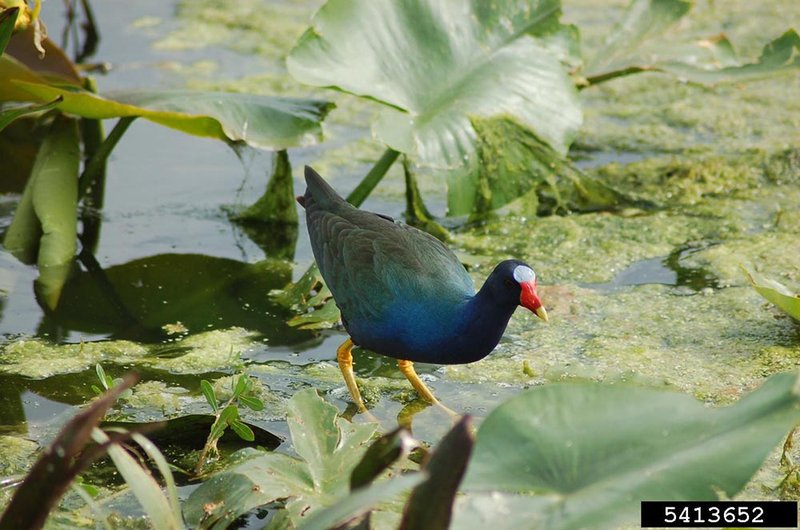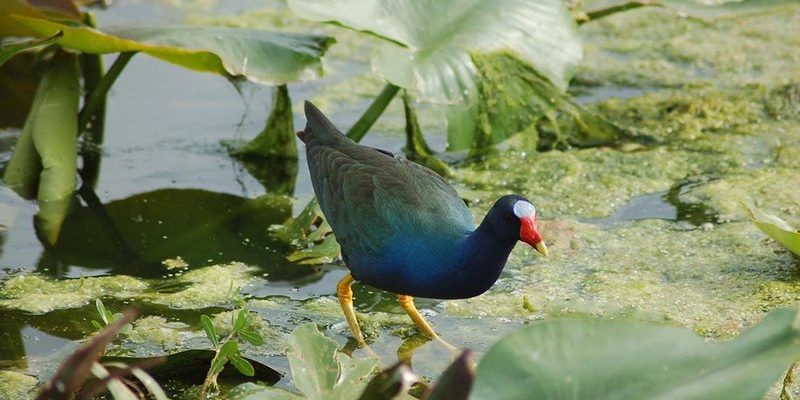
Have you ever spotted a bird so vibrant that it almost looks like it stepped out of a painting? Meet the Purple Gallinule, a stunning waterbird known for its striking colors and unique behaviors. These birds appear as if nature took a brush and splashed brilliant blues, greens, and purples together, making them a favorite among birdwatchers and nature lovers alike. With their long legs, oversized feet, and distinctive calls, they add a splash of color and life to wetlands across the Americas.
The Purple Gallinule is more than just a pretty face; they are fascinating creatures that show us a lot about wetland ecosystems. From their habits and diets to their movements and unique features, there’s much to uncover about these delightful birds. So, let’s take a closer look at what makes the Purple Gallinule such a captivating species.
Physical Characteristics
The Purple Gallinule is easily recognizable thanks to its vibrant plumage. Adults typically showcase a deep blue-purple body with a striking green back and a bright yellow beak. Their long, slender legs are a pale shade of yellow, making them look like they’re wearing a pair of bright, springy socks. These adaptations are not just for show; their large feet help them walk on floating vegetation, allowing them to navigate through their wetland habitats.
In terms of size, a typical adult Purple Gallinule measures around 13-15 inches in length. They have a wingspan of about 20-24 inches, which helps them glide gracefully over water while searching for food. Their feathers, especially on the head, can have an iridescent quality, sparkling in the sunlight. Young gallinules, however, look quite different. They have duller colors, with brown and gray hues, which serve as camouflage against potential predators.
Another remarkable feature of the Purple Gallinule is their unique toes. They possess very long toes that help them walk on soft marshy ground without sinking in. This adaptation is essential for avoiding predators and allows them to forage for food among dense vegetation. These physical traits, combined with their striking appearance, make the Purple Gallinule a truly fascinating bird.
Habitat and Distribution
Purple Gallinules thrive in various wetland environments, including marshes, swamps, and floating vegetation. Found primarily in the Southeastern United States, they also inhabit parts of Central America and the Caribbean. They prefer warm, shallow waters and often create nests in thick reeds and cattails to protect their young from predators. You might see them skimming across the water or perched on lily pads, searching for insects and other tasty treats.
During migration, the Purple Gallinule can be spotted in a variety of habitats, as they adapt well to different environments. Some prefer freshwater wetlands, while others may venture into brackish waters. Despite their adaptability, they face threats from habitat loss due to urban development and pollution, making conservation efforts essential to their survival.
Interestingly, these birds also tend to be more solitary compared to other waterfowl. While you may occasionally see them in small groups, they generally prefer to forage alone. Their ability to adapt to different wetland environments has helped them establish a broad range across North America, but changes in these habitats can put their populations at risk.
Diet and Feeding Habits
The Purple Gallinule is an omnivorous bird, meaning they consume a wide variety of foods. Their diet mainly consists of seeds, fruits, and various aquatic plants. They’re particularly fond of tender green vegetation found in their marshy homes. In addition to plant matter, they also eat insects, small fish, and crustaceans when the opportunity arises. This versatility in diet helps them thrive in different environments, especially where food sources may vary.
When foraging, Purple Gallinules use their long toes to help them walk on soft surfaces; this gives them the ability to access food sources that many other birds cannot reach. You might see them poking their heads into the water or rummaging through vegetation efficiently, showcasing their dexterous movements. Their keen eyesight and ability to detect movement allow them to spot potential meals even in dense foliage.
Interestingly, these birds can also be quite opportunistic. If food is scarce, they may scavenge or even engage in a bit of kleptoparasitism, which means stealing food from other birds. This behavior highlights their adaptability and resourcefulness in the wild, essential traits for survival in ever-changing environments.
Behavior and Social Structure
The Purple Gallinule is known for its unique behaviors, which add to its charm. Often seen moving cautiously through their habitats, they exhibit a mix of curiosity and caution. Their movements are deliberate, especially when foraging or avoiding predators. You might observe them gliding smoothly over the water or jumping confidently from one lily pad to another. Their agility is quite impressive!
In terms of social behavior, while they can be solitary, during mating season, they do tend to congregate. Males perform elaborate courtship displays to attract females, showcasing their vibrant colors and unique calls. Once a pair forms, they work together to build a nest using reeds and vegetation, often in areas that are hard to reach for predators. This teamwork highlights the strong bond between mates, which is essential for raising their young.
The chicks are born precocial, meaning they can leave the nest within hours of hatching. This early independence is crucial for survival, as they need to be able to evade predators right away. It’s fascinating to see how the parents teach their young to forage and navigate their environment, grooming them along the way. Overall, their social dynamics and behaviors are complex and add to the incredible life of the Purple Gallinule.
Conservation Status
While the Purple Gallinule has a broad distribution, its populations are not without challenges. The International Union for Conservation of Nature (IUCN) categorizes them as “Least Concern,” but that doesn’t mean they don’t face threats. Wetland habitats are disappearing at an alarming rate due to urban development, pollution, and climate change. These factors can lead to reduced nesting sites and food availability, putting pressure on their populations.
Conservation efforts are crucial to ensure the survival of the Purple Gallinule. Initiatives focused on wetland rehabilitation and protection can significantly benefit these birds. Organizations and volunteers work tirelessly to create conditions that support their natural habitats and encourage growth in their numbers. Efforts like restoring marshlands not only help the gallinules but also support a host of other wildlife that relies on these ecosystems.
As individual citizens, we can also play a role in conservation. Simple actions, like reducing pollution, participating in local clean-ups, and supporting wildlife organizations, can make a big difference. Every step helps in creating a healthier environment for these beautiful birds and the ecosystems they inhabit.
| Common Name: | Purple Gallinule |
| Scientific Name: | Porphyrio martinicus |
| Size: | 13-15 inches in length |
| Wingspan: | 20-24 inches |
| Habitat: | Wetlands, marshes, swamps |
| Diet: | Seeds, fruits, insects |
| Lifespan: | 4-5 years in the wild |
| Conservation Status: | Least Concern |
FAQ
What is the primary diet of the Purple Gallinule?
The primary diet of the Purple Gallinule consists of seeds, fruits, and various aquatic plants. They also enjoy insects, small fish, and crustaceans, making their diet quite diverse. This adaptability allows them to thrive in different environments, ensuring they have access to varied food sources throughout the year.
Where can I typically find Purple Gallinules?
You can typically find Purple Gallinules in wetlands, marshes, and swamps across the Southeastern United States, Central America, and the Caribbean. They prefer warm and shallow waters, often nesting among reeds and cattails to protect their young.
How do Purple Gallinules cope with predators?
Purple Gallinules have several strategies to cope with predators. Their ability to blend into the dense vegetation helps them avoid detection. They often forage alone to minimize attracting the attention of potential threats. When necessary, they can quickly flee into the water or fly to escape danger.
Are Purple Gallinules migratory birds?
While some Purple Gallinules are sedentary, others are migratory. During the breeding season, they typically remain in their territories, but as the seasons change, they may migrate to find suitable habitats and food sources. Their migratory patterns can vary depending on environmental conditions.
What are the vocalizations of Purple Gallinules like?
Purple Gallinules are quite vocal, producing a range of sounds including whistles, squawks, and grunts. Their calls are often loud and can vary based on their behavior—whether they are warning others of danger or communicating with their mates. These vocalizations play an essential role in their social interactions.
Can Purple Gallinules swim?
Yes, Purple Gallinules are capable swimmers. They often use their long legs and webbed feet to paddle through water while foraging for food. Although they are primarily terrestrial birds, their swimming ability helps them navigate and escape from predators when necessary.
What is the breeding behavior of Purple Gallinules?
During breeding season, males display striking behaviors to attract females, including colorful displays and unique calls. Once they mate, both parents participate in building a nest in dense vegetation, where they raise their young. This teamwork is crucial for the survival of the chicks.
How can I help conserve Purple Gallinules?
You can help conserve Purple Gallinules by supporting wetland conservation efforts, participating in local clean-ups, and advocating for sustainable practices. Every effort counts in creating a healthier environment for these beautiful birds and the ecosystems they inhabit.
What threats do Purple Gallinules face?
Purple Gallinules face threats primarily from habitat loss due to urban development and pollution. Climate change also poses risks by altering their habitats. Conservation efforts focused on protecting and restoring wetland environments are essential for their survival and well-being.

